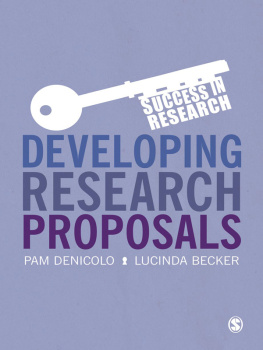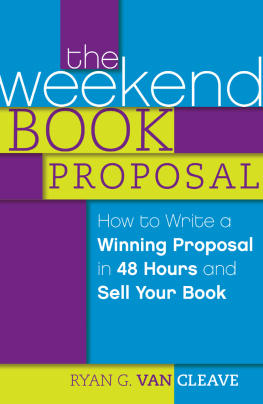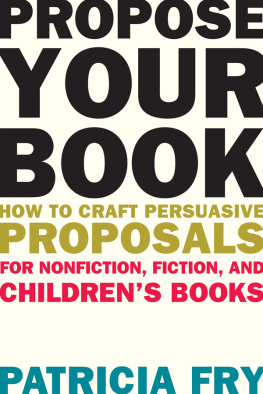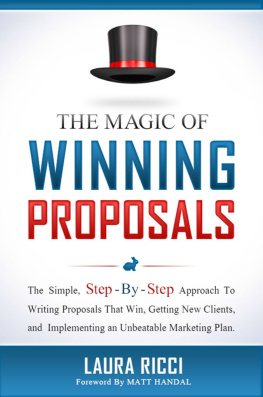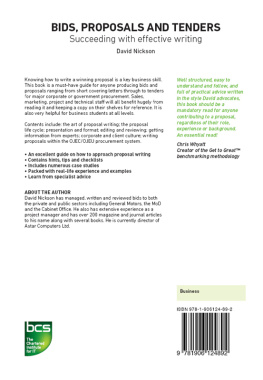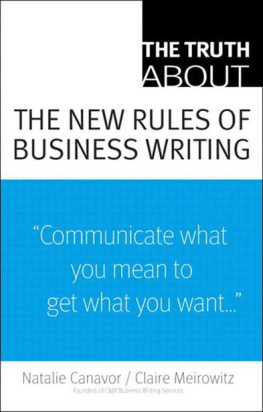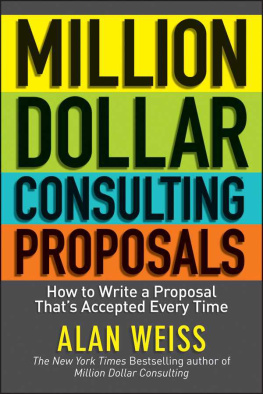Writing Winning Business Proposals
Third Edition
RICHARD C. FREED
JOSEPH D. ROMANO
SHERVIN FREED


For Julie, Sarah, Adele, Bruce, Marcia,
Renee, Terese, and Amara
Copyright 2011 by The McGraw-Hill Companies, Inc. All rights reserved. Except as permitted under the United States Copyright Act of 1976, no part of this publication may be reproduced or distributed in any form or by any means, or stored in a database or retrieval system, without the prior written permission of the publisher.
ISBN: 978-0-07-174233-7
MHID: 0-07-174233-6
The material in this eBook also appears in the print version of this title: ISBN: 978-0-07-174232-0, MHID: 0-07-174232-8.
All trademarks are trademarks of their respective owners. Rather than put a trademark symbol after every occurrence of a trademarked name, we use names in an editorial fashion only, and to the benefit of the trademark owner, with no intention of infringement of the trademark. Where such designations appear in this book, they have been printed with initial caps.
McGraw-Hill eBooks are available at special quantity discounts to use as premiums and sales promotions, or for use in corporate training programs. To contact a representative please e-mail us at bulksales@mcgraw-hill.com.
This publication is designed to provide accurate and authoritative information in regard to the subject matter covered. It is sold with the understanding that neither the author nor the publisher is engaged in rendering legal, accounting, securities trading, or other professional services. If legal advice or other expert assistance is required, the services of a competent professional person should be sought.
From a Declaration of Principles Jointly Adopted by a Committee of the
American Bar Association and a Committee of Publishers and Associations
TERMS OF USE
This is a copyrighted work and The McGraw-Hill Companies, Inc. (McGraw-Hill) and its licensors reserve all rights in and to the work. Use of this work is subject to these terms. Except as permitted under the Copyright Act of 1976 and the right to store and retrieve one copy of the work, you may not decompile, disassemble, reverse engineer, reproduce, modify, create derivative works based upon, transmit, distribute, disseminate, sell, publish or sublicense the work or any part of it without McGraw-Hills prior consent. You may use the work for your own noncommercial and personal use; any other use of the work is strictly prohibited. Your right to use the work may be terminated if you fail to comply with these terms.
THE WORK IS PROVIDED AS IS. McGRAW-HILL AND ITS LICENSORS MAKE NO GUARANTEES OR WARRANTIES AS TO THE ACCURACY, ADEQUACY OR COMPLETENESS OF OR RESULTS TO BE OBTAINED FROM USING THE WORK, INCLUDING ANY INFORMATION THAT CAN BE ACCESSED THROUGH THE WORK VIA HYPERLINK OR OTHERWISE, AND EXPRESSLY DISCLAIM ANY WARRANTY, EXPRESS OR IMPLIED, INCLUDING BUT NOT LIMITED TO IMPLIED WARRANTIES OF MERCHANTABILITY OR FITNESS FOR A PARTICULAR PURPOSE. McGraw-Hill and its licensors do not warrant or guarantee that the functions contained in the work will meet your requirements or that its operation will be uninterrupted or error free. Neither McGraw-Hill nor its licensors shall be liable to you or anyone else for any inaccuracy, error or omission, regardless of cause, in the work or for any damages resulting there from. McGraw-Hill has no responsibility for the content of any information accessed through the work. Under no circumstances shall McGraw-Hill and/or its licensors be liable for any indirect, incidental, special, punitive, consequential or similar damages that result from the use of or inability to use the work, even if any of them has been advised of the possibility of such damages. This limitation of liability shall apply to any claim or cause whatsoever whether such claim or cause arises in contract, tort or otherwise.
Contents
Preface
This book is written for business people who prepare proposals (and for business people who evaluate them). If you are a consultant who owns your own business or who works for a firm of one or one thousand, if you are an internal consultant who sells services to your own organization, if you are a business executive who sells ideas to your management, you will benefit greatly from this book.
If you are like most people, you probably find selling your services or ideas in a proposal both demanding and difficult. Your proposals not only take too long to prepare, they are often written when you least want to write themat night or on weekends, because during the day you are occupied with everything else that you do: conducting projects, furthering relationships, developing people. Proposal writing often seems like extra work, additional but necessary effort to get selected to perform projects so that you can be successful in your intensely competitive business.
Perhaps equally frustrating is the margin of difference between winning and losing. Hundreds of people consulting in the private sector have told me the same thing: the difference between winning and coming in second is very small, often just two to five points on a hundred-point scale. Those who place a close second never get back the upfront costs of proposal development. What they do get is second place. The situation in the public sector is similar. For a recent proposal to manage a $30 million project for a U.S. government agency, the difference between the winner and the second-place also-ran was five points out of one thousandone-half of 1 percent!
What accounts for this difference? Sometimes its price, of course, sometimes your particular methodology or your qualifications. But all too often, its heads. That something has to do with relationships, with the buyers feeling that you are right, that you understand, that you are compatible. So, yes, price is frequently a consideration, as is expertise. But someone is always or can always be less costly, and the world is full of experts. Price and expertise get you in the running, but they dont ensure that youll win.
The goal of this book is twofold:
Specifically, to get you the additional two to five points necessary to win
Generally, to increase your win rate, your hit rate
By how much? Thats impossible to say, of course, though some data suggest that it might be considerable. The concepts in Writing Winning Business Proposals (WWBP) are the same ones taught in a two-day program that has been offered to organizations large and small in more than 25 countries on five continents over the last 20 years. The largest organization tracked over one year the performance of those who had taken the two-day program and those who hadnt. Following are the results. (See .)
When you calculate the number of proposals won by the number of proposals submitted, the participants hit rate percentage (proposals won divided by proposals submitted) was 30 points higher. More interesting is that when hit rate was weighted using the monetary value of the proposals won compared to the total value submitted, the hit rate percentage more than doubled, suggesting that participants were able to sell higher-value work than those who had not taken the program. As you read the contents of WWBP, youll clearly understand why.



